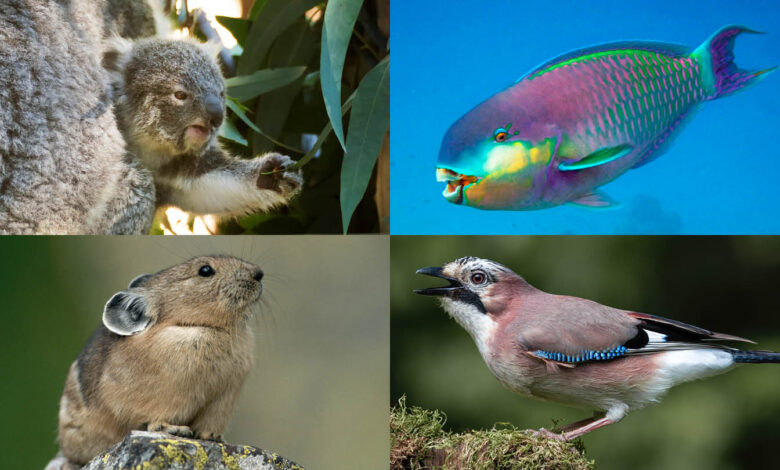Eating poop is surprisingly common among animals


B12: Also known as cobalamin, it’s a vitamin that plays a role in the proper function and development of blood cells and many types of tissues. These include the brain and nerves.
bat: A type of winged mammal comprising more than 1,400 separate species — or one in every four known species of mammal.
biologist: A scientist involved in the study of living things.
biology: The study of living things. The scientists who study them are known as biologists.
birds: Warm-blooded animals with wings that first showed up during the time of the dinosaurs. Birds are jacketed in feathers and produce young from the eggs they deposit in some sort of nest. Most birds fly, but throughout history there have been the occasional species that don’t.
cavefish: A small, colorless fish that lives only in limestone caves in North America.
clinical: (in medicine) A term that refers to diagnoses, treatments or experiments involving people.
conservation: The act of preserving or protecting something. The focus of this work can range from art objects to endangered species and other aspects of the natural environment.
coprophagy: The eating of feces or dung.
diet: (n.) The foods and liquids ingested by an animal to provide the nutrition it needs to grow and maintain health. Sometimes this is a specific food-intake plan.
element: A building block of some larger structure.
evolutionary biologist: Someone who studies the adaptive processes that have led to the diversity of life on Earth. These scientists can study many different subjects, including the microbiology and genetics of living organisms, how species change to adapt, and the fossil record (to assess how various ancient species are related to each other and to modern-day relatives).
feces: A body’s solid waste, made up of undigested food, bacteria and water. The feces of larger animals are sometimes also called dung.
forage: To search for something, especially food. It’s also a term for the food eaten by grazing animals, such as cattle and horses.
gut: An informal term for the gastrointestinal tract, especially the intestines.
hatchling: A young animal that recently emerged from its egg.
internet: An electronic communications network. It allows computers anywhere in the world to link into other networks to find information, download files and share data (including pictures).
internship: A training program where students learn advanced professional skills by working alongside experts. People who participate in these training programs are called interns. Some intern in medicine, others in the sciences, journalism or business.
journal: (in science) A publication in which scientists share their research findings with experts (and sometimes even the public). Some journals publish papers from all fields of science, technology, engineering and math, while others are specific to a single subject. Peer-reviewed journals are the gold standard: They send all submitted articles to outside experts to be read and critiqued. The goal, here, is to prevent the publication of mistakes, fraud or work that is not novel or convincingly demonstrated.
literature: The books, studies and other writings published on a particular subject. Scientific literature usually refers to published papers or meeting abstracts describing new research findings or the reviews of multiple papers on a topic within some field.
microbe: Short for microorganism. A living thing that is too small to see with the unaided eye, including bacteria, some fungi and many other organisms such as amoebas. Most consist of a single cell.
molecule: An electrically neutral group of atoms that represents the smallest possible amount of a chemical compound. Molecules can be made of single types of atoms or of different types. For example, the oxygen in the air is made of two oxygen atoms (O2), but water is made of two hydrogen atoms and one oxygen atom (H2O).
nutrient: A vitamin, mineral, fat, carbohydrate or protein that a plant, animal or other organism requires as part of its food in order to survive.
nutrition: (adj. nutritious) The healthful components (nutrients) in the diet — such as proteins, fats, vitamins and minerals — that the body uses to grow and to fuel its processes. A scientist who works in this field is known as a nutritionist.
recycle: To find new uses for something — or parts of something — that might otherwise be discarded, or treated as waste.
sanitation: The protection of human health by preventing human contact with our own bodily wastes, through hand washing, use of things like use of toilets or latrines, separation of disposal of wastes from drinking-water sources and water, and cleaning water to rid of disease causing agents disinfecting foods and materials that may be ingested or otherwise enter the body.
species: A group of similar organisms capable of producing offspring that can survive and reproduce.
tortoise: Any of various turtles that live on land.
traditional medicine: A term for therapies and treatments that have evolved by trial and error and then been spread by word of mouth. Many of these are plant-based therapies that tribal peoples or old-style “healers” have learned from their elders. Scientists have sometimes found that these work. But with research, modern medicine often can develop a more potent version in the lab or one that does not require harvesting rare species.
vertebrate: The group of animals with a brain, two eyes, and a stiff nerve cord or backbone running down the back. This group includes amphibians, reptiles, birds, mammals and most fish.
vitamin: Any of a group of chemicals that are essential for normal growth and nutrition and are required in small quantities in the diet because either they cannot be made by the body or the body cannot easily make them in sufficient amounts to support health.
waste: Any materials that are left over from biological or other systems that have no value, so they can be disposed of as trash or recycled for some new use.
Western: (n. the West) An adjective describing nations in Western Europe and North America (from Mexico northward). These nations tend to be fairly industrialized and to share generally similar lifestyles; levels of economic development (incomes); and attitudes toward work, education, social issues and government.



